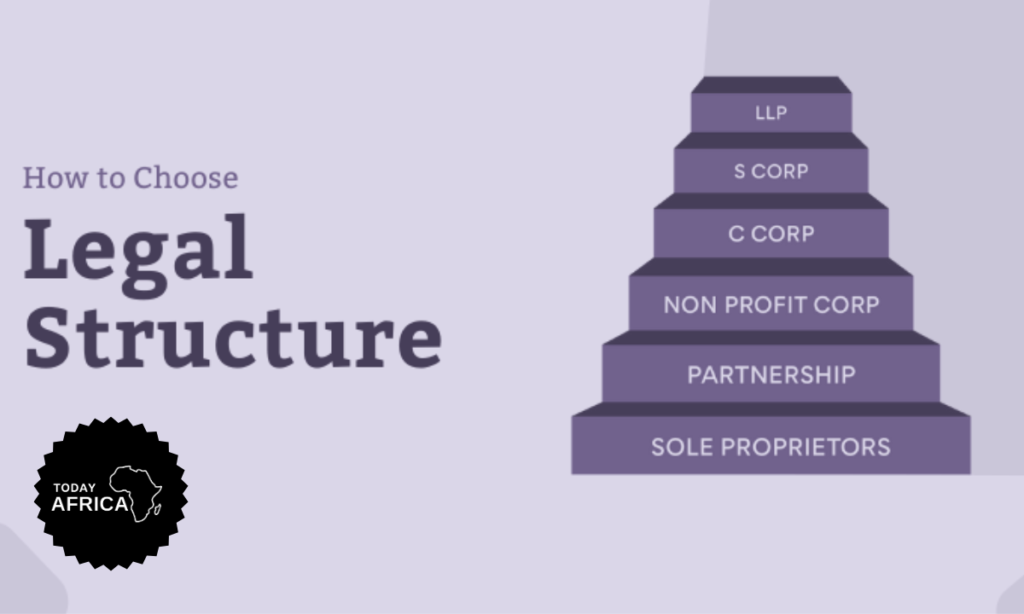Companies are founded for various purposes, such as for the provision of goods or services, for philanthropic reasons, and other valid reasons involving profit-making.
Starting a business can be a difficult task and as a founder, you’re required to take complex steps and adhere to the various regulatory compliance.
The issue of the type of business structure, the purpose of the business, the organization or management, recruitment of staff, and other important factors should be considered.
However, the first thing to take into account is the type of business structure the owner wants to operate because choosing the wrong structure may have severe legal implications for the business.
Here in my country, Nigeria, depending on the nature of the business you want to operate, your business may be registered as a company, business name, or incorporated trustee at the Corporate Affairs Commission (CAC).
What is a Business Legal Structure?
A business legal structure is the form of your business that determines what licensing you need, what taxes you will pay, and what legal rights your business has. You should understand that every entrepreneur’s situation is different, which makes choosing a business structure a very personal decision.
Why is a business legal structure important?
1. Taxes: Sole proprietors, partnership owners, and S corporation owners categorize their business income as personal income. C corporation income is business income separate from an owner’s personal income. Given the different tax rates for business and personal incomes, your structure choice can significantly impact your tax burden.
2. Paperwork: Each business legal structure has unique tax forms. Additionally, if you structure your company as a corporation, you’ll need to submit articles of incorporation and regularly file certain government reports.
Read Also: Top 21 Startup Accelerators in Africa
3. Hierarchy: Corporations must have a board of directors. Corporate hierarchies also prevent business closure if an owner transfers shares or exits the company, or when a founder dies. Other structures lack this closure protection.
4. Registration: A business legal structure is also a prerequisite for registering your business.
5. Fundraising: Your structure can also block you from raising funds in certain ways. For example, sole proprietorships generally can’t offer stocks. Your initial choice of business structure is crucial, although you can change your business structure in the future.
Types of Business Structures

1. Sole proprietorship
The simplest business structure is the sole proprietorship. Your business is a sole proprietorship if you don’t create a separate legal entity for it. This is true whether you operate it in your own name, or under a trade name.
The main advantage of a sole proprietorship is that it’s fairly simple and inexpensive. The disadvantage is that it doesn’t create a legal separation between you and your personal assets and your business assets. If you’re sued or your business folds, your personal assets are fair game for creditors and in terms of legal liability.
How do you form a sole proprietorship?
As we have already established that a sole proprietorship is the easiest business to form; no official registration action is required on your part.
So, if you’re a fashion designer with a couple of clients? Congratulations—you’re a sole proprietor.
However, there will still likely be registrations, permits, and regulatory hoops to jump through, depending on your country. You’ll want to check with the organization in charge of business registrations in your country.
2. Partnership
Let’s you’re a personal trainer, who started a sole proprietorship business and offers client coaching.
Later, you want to pair up with a nutritionist, and the two of you plan on building a fitness empire together. You both share ownership and have shared input and participation in the company.
Now you have a partnership.
So a partnership involves two or more individuals sharing ownership of their new business. They’ll both contribute to the business in some way and share in both profits and losses.
However, your partnership agreement should clearly define what happens if a partner withdraws, buy and sell arrangements for partners, and liquidation arrangements if that becomes necessary.
Related Post: How to Choose the Right Name for Your Business
If you think a partnership might work for your business, make sure you do it right. Do well to contact an attorney with experience in partnerships, and ask them for guidance.
Types of partnerships
1. General partnership: A general partnership assumes that all parties are equally involved; that is to say, all profits, liabilities, and duties within the company are distributed evenly. If there is an intentionally unequal split in the partnership (for instance, if one partner opts to accept a greater portion of work in exchange for a greater profit share), this must be noted in the official partnership agreement.
2. Limited partnership: A limited partnership (also known as a partnership with limited liability) is often used for partners who serve an investor role only, and have limited input into the actual running of the company.
3. Joint venture: If you plan on partnering up for one specific project, a joint venture might be for you. Joint ventures function the same as a general partnership but for a confined span of time, such as the completion of a one-time project.
3. Limited Liability Corporation (LLC)
A limited liability corporation (or LLC) allows for the flexibility of a partnership or sole proprietorship, but, as the name suggests, limits the liability of those involved, similar to a corporation.
An LLC is usually a lot like an S corporation and offers a combination of some limitation on legal liability and some favorable tax treatment for profits and transfer of assets.
It’s a good idea to talk to an attorney if you’re interested in setting up an LLC.
4. Corporation
A corporation is the most complex business structure; so, if you’re starting a very small business and are working either by yourself or with just a few others (like a partner or a few employees), then a corporation might not be for you.
This business structure is recommended for companies that are larger and more established, have many employees, intend to sell stock in their company, will be scaling quickly, have many outside investors, or some combination of these traits.
Types of corporations
1. C corporation: In C corporation all shareholders combine funds and are then given stock in the newly formed business.
2. S corporation: An S corp is similar to a traditional C corporation, with one major difference: Profits and losses can be “passed through” to your personal tax return.
The S corporation is used for family companies and smaller ownership groups. The biggest difference between a C corp and an S corp is that the S corporation’s profits or losses go straight through to the S corporation’s owners, without being taxed separately first. Click here to learn more about S corporation
3. B corporation: Does your company have a dedicated social mission, a good cause built into its foundation that you’d like to continue furthering as your company grows?
If so, you might want to consider becoming a B corporation, which stands for “benefit corporation.”
However, the name is a bit misleading; a B corp isn’t an entirely different structure than a regular C corporation. It’s merely a C corp that has been vetted and approved for B corp status. Click here to learn more about B corporation
Comparison of Business Legal Structures
| Legal Structure | Liability Protection | Tax Treatment | Management Structure | Cost of Setup and Operation |
| Sole Proprietorship | No protection | Business income taxed on personal income tax return | Owner has complete control | Low |
| Partnership | No protection | Business income taxed on personal income tax return | Shared decision-making | Low |
| LLC | Limited protection | Business income taxed as partnership or corporation | Flexible management structure | Moderate |
| Corporation | Most protection | Business income is taxed at the corporate level and again at the individual level | Managed by a board of directors | High |
Factors to Consider Before Choosing a Legal Structure of Your Business
1. Control
An important factor to consider when selecting your structure is the level of control you wish to have over your business. For example, if you wish to own and operate the enterprise completely alone then being a sole trader would be the most appropriate structure.
In a partnership or LLC, decision-making is shared among the partners or members. In a corporation, shareholders elect a board of directors to make major decisions, and they may have less direct control depending on their proportion of share ownership.
Your choice of structure will affect what aspects of the business you will control and what aspects you will legally own.
2. Limitation of liability
Your choice of business legal structure will have important implications on your potential legal liability. So, when choosing a structure for your business, it is important to consider the legal and liability implications of each option.
Considering the extent you need to be protected from personal legal liability is important before choosing a structure.
As a sole proprietor or a partner offers no protection from personal liability, which means that you’re personally responsible for all debts and legal issues that arise from the business. A limited liability company (LLC) and corporation offer limited or complete protection from your personal liability, respectively.
It’s important to consult with an attorney to determine which legal structure is most appropriate for your business.
3. Complexity
The different structures each have differing setup procedures, costs, and complexities involved. For example, as a sole trader, it’s simple to set up with a few reporting requirements, a more complex structure involves strict reporting requirements and must be set up by an accountant.
4. Taxes
The structure of your business will have significant effects on the amount of tax you pay and the kinds of tax that you must pay. For example, a sole trader enjoys tax benefits from being able to claim on a personal tax return.
A sole proprietorship and partnership are both taxed as pass-through entities, which means that the business’s income is taxed on the owner’s personal tax returns. An LLC can be taxed as either a pass-through entity or a corporation, depending on the members’ preference. A corporation is taxed at the corporate level and again at the individual level when dividends are paid to shareholders.
It is important to consult with a tax professional to determine which tax treatment is most beneficial for your business.
5. Flexibility and future need
It is important when considering a business structure to also reflect on where you envision your business going in the future. What kind of expansion do you plan? Do you need to be able to sell shares or add new members?
A business structure that limits these options is not beneficial when you may need to make changes in the future. Consider a legal entity such as an LLC or corporation. It provides more flexibility for your business growth than other structures like sole proprietorship or partnership.
6. Management structure
How do you want your business to be managed? Do you want to have a set of rules and procedures that you need to follow? A limited liability company offers advantages in terms of both its management structure and the amount of paperwork required. It allows for a separation between owners and managers, which can be beneficial if you plan on seeking outside investment or adding members in the future.
7. Ownership structure
How many owners will have the business, and how will ownership be transferred? The number of owners can influence the choice of business structure.
For example, a sole proprietorship is suited for single-owner businesses. If there are two or more owners, a partnership, LLC, or corporation might be more appropriate.
8. Ongoing administration
Whilst a sole trader structure has few reporting and administrative requirements. It also has complex legal structures such as a corporation have strict and difficult record-keeping and paperwork requirements. In fact, an important consideration before setting up a complex structure is ensuring that you have the time, people, and ability to abide by the strict record-keeping requirements that are legally enforceable.
9. Continuity of existence
It is important to consider how you see the business coming to a conclusion. If you wish for the business to be terminated, then becoming a sole trader is the most appropriate option. However, if you wish to secure your family’s financial future. It is more appropriate to select a structure that does not come to an end if you are incapacitated.
References:
















